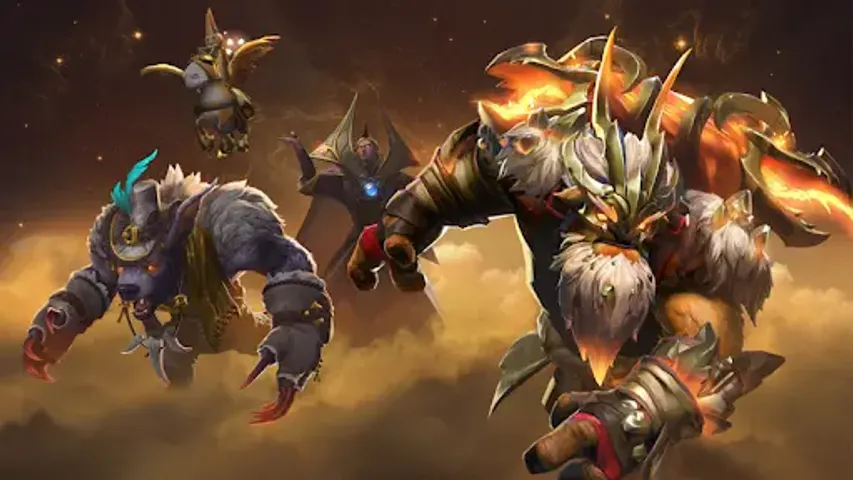- Smashuk
Guides
11:46, 17.07.2024

Dota 2 is a complex and multifaceted game where each match unfolds in three key stages: early game, mid game, and late game. While all these stages are important, it is the late game that determines which team will emerge victorious. The late game is characterized by high-level players, developed heroes, and intense team fights. In this article, we will discuss key strategies and tips that will help your team secure victory in the final stages of the game.
Map Awareness and Information Advantage
Control of the map in the late game is a critical aspect that significantly affects your team's ability to make strategically correct decisions. In the final stages of the game, where mistakes can cost victory, map control allows your team to have an informational advantage over the opponent.
Maintaining control over key points on the map helps avoid unexpected attacks and ambushes, which is especially important when moving around the map. For example, controlling Roshan's lair allows you to monitor the enemy's attempts to kill this neutral monster and prepare in advance for a fight over him. Additionally, warding in the forests and approaches to your base provides crucial information about enemy movements, allowing you to effectively respond to their actions.
Placing wards in key points on the map, such as high grounds, forest paths, and potential ambush spots, ensures constant visibility and allows you to control the situation. It is important to constantly update the wards, as the opponent will inevitably try to destroy them.
Object Control
- Roshan: In the late game, control over Roshan becomes one of the most important objectives. Killing him grants the team an Aegis, allowing one of your key players to resurrect after death. This can significantly change the course of a fight. Often, matches are decided around Roshan.
- Towers and Barracks: Destroying the enemy's barracks and towers leads to the emergence of stronger creeps, forcing the opponent to defend their base. It is important to coordinate attacks and choose the right moment to assault the enemy base, as an unsuccessful attack can result in the loss of key heroes and a counterattack from the opponent.

Communication
In the final stages of the game, team coordination becomes critical. Constant communication between players allows for quick responses to changing situations on the map, planning attacks, and defense. Using voice chat or other communication tools can significantly improve the effectiveness of team actions. Voice chat allows for instant reporting of enemy sightings, hero movements, possible ambushes, and other important events. During team fights and attacks on objects, quick coordination helps to execute strategies smoothly. Rapid response to sudden events, such as an unexpected enemy attack, is facilitated by voice chat, enabling quick reactions and coordinated actions for defense or counterattack. For maximum communication efficiency, use clear and concise phrases, report the most important events first, and maintain a positive team atmosphere.

Roles and Positions
Each player on the team has their role, and in the late game, it is important to adhere to their tasks. Carry heroes should focus on killing enemies and objects, accumulating resources, and buying items that enhance their combat effectiveness. They must take safe positions in battles, defending against enemy attacks and dealing maximum damage. Tanks should be on the frontline, absorbing enemy hits and protecting more fragile allies. They can also initiate fights with their control abilities, positioning themselves between enemies and their allies. Supports focus on supporting the team, providing vision control and crowd control, using their abilities to heal allies, provide buffs and debuffs, and control enemy positions on the battlefield.
Item Selection
- Key Items: In the late game, the right choice of items can determine the outcome of the match. It is important to buy items that enhance your hero and counter the enemy. For example, Black King Bar (BKB) provides immunity to magical attacks, which can be crucial in team fights. Satanic offers significant health regeneration, while Abyssal Blade allows for stunning enemies.
- Situational Items: Besides key items, it is important to consider the situation on the battlefield and buy appropriate items. If an enemy hero is causing the most problems, it might be worth investing in an item that neutralizes them. For instance, if the enemy has a strong physical damage dealer, it is worth purchasing items that increase your armor or health.

Initiation
It is crucial to have a hero who can quickly and effectively start a fight by catching key enemies. Such heroes can be Enigma with Black Hole or Tidehunter with Ravage. Other heroes like Magnus with Reverse Polarity or Earthshaker with Echo Slam can also perform this role. Proper initiation can secure victory in a fight before it even begins, creating favorable conditions for the team and significantly complicating the situation for the enemy. The main thing is that the initiator receives the necessary support from the team to execute their abilities, as well as having enough survivability to withstand enemy strikes. Additionally, timing and location of initiation are crucial, choosing the moment when the enemy is most vulnerable.


Positioning
Hero placement in a fight is a crucial factor. Tanks and initiators should be on the frontline, absorbing damage and controlling enemies. Carry heroes and supports should be positioned at the back, providing maximum damage and support to the team. Incorrect positioning can lead to the quick loss of key heroes and defeat in the fight. It is important for supports to maintain a safe distance, having the ability to timely use their abilities and items for protection and healing of allies. Carry heroes should take positions that allow them to fully realize their potential while avoiding unnecessary risks. Additionally, understanding the terrain and using cover can significantly improve the chances of successful positioning, as it allows avoiding unexpected attacks and quickly adapting to the changing situation on the battlefield.
Stress Resistance
The late game is often accompanied by high stress levels due to the importance of every decision. It is crucial to stay calm and not panic, as stress can lead to wrong decisions and loss of advantage. Maintaining composure helps to better assess the situation and make thoughtful decisions. Experienced players know that panic in critical moments can ruin even the best strategy, so the ability to control emotions is an important element of success. Taking breaks during short pauses in the game, deep breaths, and focusing on specific tasks can help reduce stress levels.
Team Morale
In the late game, the opponent's actions can change very quickly. It is important to constantly analyze their moves and adapt your strategy accordingly. If the opponent changes tactics, it is worth reviewing your plans and finding new ways to counteract. This requires high concentration and the ability to make quick decisions from the team. Analyzing enemy actions, such as sudden movements, new items, or role changes, will help identify their weaknesses and adjust your strategy for maximum effect. Using replays and discussing enemy actions during the game can provide additional information for adaptation.


Flexibility in Strategies
Flexible strategies allow your team to quickly react to changing situations on the battlefield. It is important to have several backup plans and be ready to change tactics at any moment. This may include changing positions, replacing items, or reviewing player roles. For example, if your carry cannot effectively perform their role due to constant pressure from the enemy, it might be worth changing their position or even role within the team. It is also important to be ready to change the item set depending on the situation, buying what best suits the current conditions. Flexibility in strategies also includes the ability to quickly respond to enemy initiatives, changing your positioning or fighting tactics. This approach ensures your team an advantage in dynamic and unpredictable late-game situations.
Conclusion
Securing victory in the final stages of a Dota 2 game requires a comprehensive approach and excellent coordination between players. The late game is the most crucial part of the match, where every decision has great significance and can influence the final outcome. To achieve success, your team must have a clear understanding of the map, ensure control over key objectives such as Roshan and enemy towers, and maintain effective communication.
The proper distribution of roles and appropriate item selection are also decisive factors in the late game. Each player must fulfill their duties, from the carry dealing the main damage to the support who assists the team and provides vision control. Stress resistance and positive team morale help maintain focus and make well-considered decisions even in the most intense moments.
Adaptation to changes and flexibility in strategies allow for prompt reactions to enemy actions, altering tactics and approaches depending on the situation. Using replay analysis and constant discussion of enemy actions during the game helps identify their weaknesses and adjust your strategy.
Ultimately, success in the late game depends on teamwork, strategic thinking, and the ability to quickly adapt to changes. By adhering to these principles, your team can secure victory in the final stages of the game and achieve the desired result.
Comments
Upcoming Top Matches
Latest top articles







No comments yet! Be the first one to react